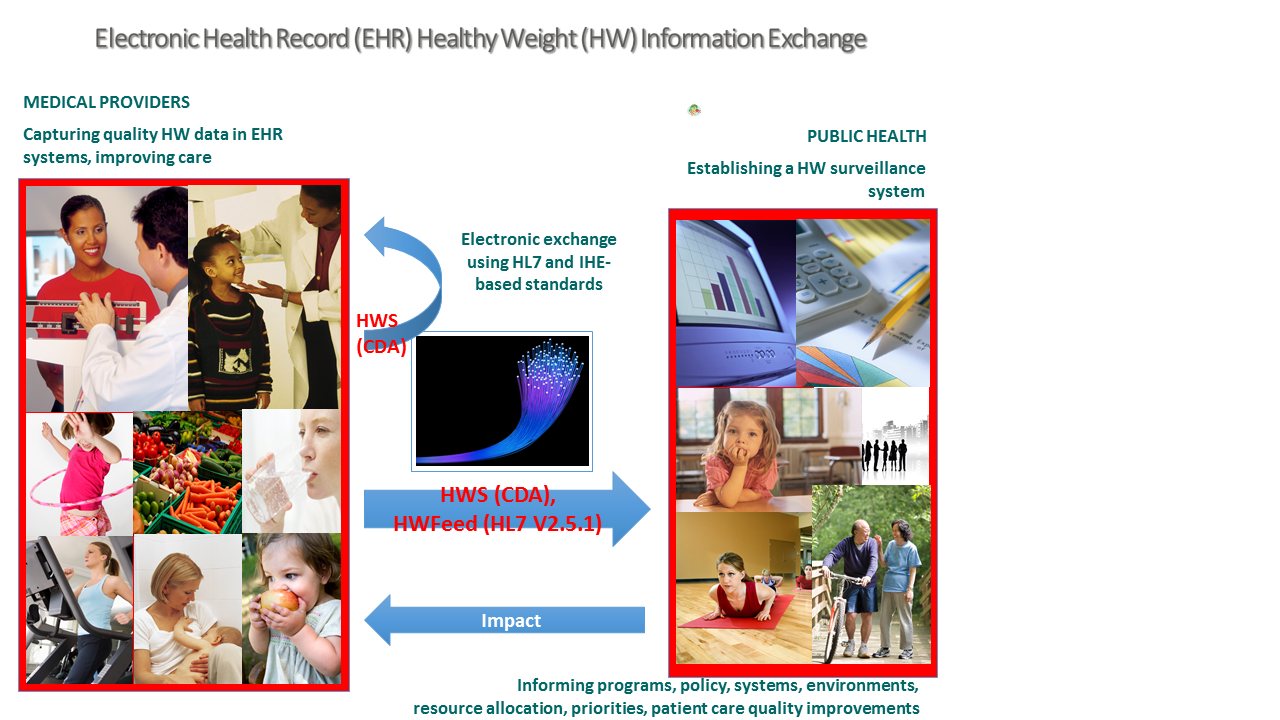Healthy Weight
Healthy Weight provides a means to capture and communicate information needed for managing and monitoring healthy weight among clinical systems and public health surveillance systems.
Summary
Measured height and weight data are captured in Electronic Health Records (EHR) and are a valuable resource for public health surveillance and quality improvement activities. Fully integrated healthy weight standards in public health agency information systems have the potential to provide high quality body mass index (BMI) data that can be used by the public health community for healthy weight surveillance activities that track changes in BMI prevalence and for developing data driven program interventions this data can be used to quantitatively evaluate the impact of child obesity prevention interventions.
This IHE profile supports alignment between the EHR and public health initiatives and approaches by specifying the content and transactions to be used to capture BMI data from the EHR and communicate the BMI data to Public Health and among EHR systems for care management.
Benefits
<If the profile can improve Cost, Safety, Quality or Efficiency then list the specific examples of that benefit (e.g. error reduction, increased throughput) and how they come about (e.g. SWF reduces patient errors due to mistyped demographics at the modality by transfering demographics electronically from the Order Filler). Consider using a bullet list for readability. Such benefits help users and vendors make the business case for the profile. If the profile does not improve any aspect of Cost, Safety, Quality or Efficiency feel free to talk about something else here.>
Details
<A few paragraphs, if appropriate, providing more details (mostly in user-speak, not tech-speak) on what the profile does and how it works.>
<If the user might be familiar with the mechanisms used by the profile, you can mention them here. E.g. Evidence Documents is based on DICOM Structured Report (SR) Templates.>
<If the user might have an appreciation for the problems addressed in the profile, you can mention them here, but keep it short. E.g. Mapping HL7 Order fields to DICOM Modality Worklist attributes can be inconsistent in the marketplace, so Scheduled Workflow provides vendors with more detailed instructions.>
Systems Affected
<List (in user terms) the types of systems they might expect to have implemented actors from this profile, e.g. RIS, PACS, HIS, CAD Workstation, etc. and for each, how it would participate.>
- PACS systems may store, manage, and/or display Evidence Documents.
- Display systems may query, retrieve and display Evidence Documents.
- Reporting workstations may retrieve, process and include details from Evidence Documents in reports
Actors & Transactions:
<Insert an actor-transaction diagram, and or list of Content Definitions>
Specification
Profile Status: Final Text <Replace "Final Text" with "Trial Implementation" or "Public Comment" as appropriate.>
Documents:
<Provide direct links to the specific volumes or supplements, and list the volume sections relevant to this profile. This is a simple inventory of official normative and informative text. If you would like to provide a reading guide or walkthrough of what is in each of the different sections for implementers or users, do that in the Profile FAQ or the Profile Implementation Page linked below. If the profile uses transactions from multiple Tech. Frameworks, repeat the structure below.>
IHE Radiology Technical Framework:
Underlying Standards:
<list all the standards on which the profile is based; if possible with links to sources>
See Also
<The following sections can be left out if there is nothing to point to. This is just to show where such information can go.>
Related Profiles
<List profiles this one depends on, profiles that depend on this one, profiles that are synergistic with this one. Start with the name of the other profile as a link and then explain the relationship.>
- Reporting Workflow [RWF] may use Evidence Documents as inputs to the reporting process.
- Simple Image & Numeric Reports [SINR] may include data copied from Evidence Documents.
- Cross-enterprise Document Sharing for Imaging [XDS-I] can be used to share Evidence Documents between sites over a network.
- Portable Data for Imaging [PDI] can store Evidence Documents on media such as CDs.
- Import Reconciliation Workflow [IRWF] can fix patient ids, etc. of Evidence Documents when importing.
Consumer Information
The Profile FAQ Template answers typical questions about what the Profile does. <Replace the link with a link to the actual FAQ page for the Profile>
The Profile Purchasing Template describes considerations when purchasing equipment to deploy this Profile. <Replace the link with a link to the actual Purchasing page for the Profile>
Implementer Information
The Profile Implementation Template provides additional information about implementing this Profile in software. <Replace the link with a link to the actual Implementation page for the Profile>
Reference Articles
<List References (good and bad) (with link if possible) to Journal Articles that mention IHE's work (and hopefully include some analysis). Go ahead, Google: IHE <Profile Name> abstract or Google: IHE <Profile Name> and under the "more" select "Scholar". You might be surprised. >
This page is based on the Profile Overview Template
